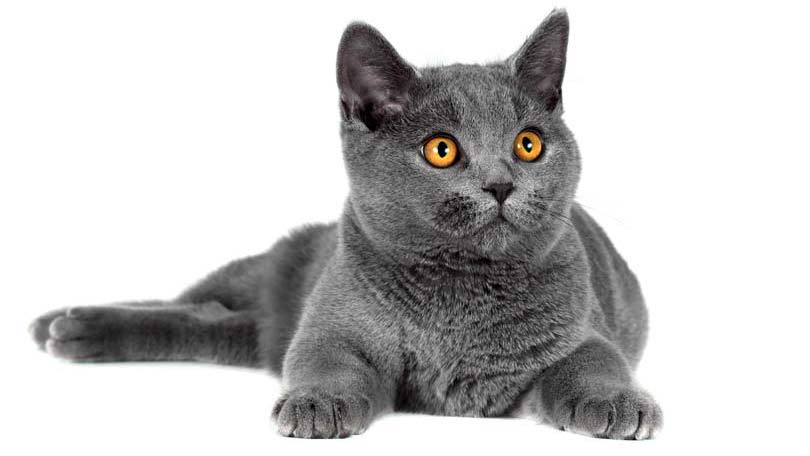
For many years, veterinarians have known that obesity in cats seemed to make the obese patient more likely to get diabetes. In fact, most of us thought that overweight actually caused diabetes. Today, I do not believe excess pounds in a cat are a cause of this condition. I believe that obesity in the cat and feline diabetes have the same “parent” causes, but are not a cause of one another. Although we do see many feline diabetics that are also quite overweight, these cats are probably genetically predisposed to get both of these problems from the same root causes. Because we often see cats that have one, but not both, of these conditions, this is undoubtedly because of each cat’s unique genetic make-up. The significant numbers of always-slender cats that have full-blown diabetes suggest that being proper weight does not protect from this disease. Also, we see very overweight cats that become diabetic, but then recover from their diabetes easily on proper diet and insulin, long before they lose the weight they need to lose.
If obesity doesn’t directly cause diabetes, then what does? Well, with cats just as with people, it definitely pays to have good genes. Some cats simply have genes that make them more or less likely to get diabetes, and more or less likely to get lots of other diseases as well. The story doesn’t stop there, though. Other environmental factors play a big part in either getting or avoiding a disease such as diabetes. Without question, for the cat (and for most humans as well), the most important environmental factor that causes diabetes is diet. Because today’s indoor cat is almost always eating dry cat food, with its extremely high processed carb (essentially sugar) content, a cat with any genetic tendency to become obese and/or become diabetic will do just that when sugar is a large part of its diet. In my many years of practice, I have never seen a diabetic cat that was eating canned food only. Also, I have never seen an overweight cat that was eating canned food only. The onset of obesity and diabetes is triggered by constant flooding of the cat’s system with refined carbohydrate from the dry diet, day after day, month after month and year after year. This steady sugar rush finally exhausts the small pancreatic capabilities of the carnivore because the cat’s evolution never prepared it for a constant high-sugar diet. In some cats, relentless sugar surges cause the cat pancreas to turn that sugar to fat. Obesity, with or without diabetes, follows.
Q: How do I know if my cat has diabetes?
The most common signs of diabetes in almost any animal, including humans, is increased thirst and increased urine output. If you see these in your cat, see a veterinarian immediately. Some diabetic cats will also lose weight unexpectedly (many are overweight to begin with because they are eating dry cat food), begin vomiting, have diarrhea, and become listless. Any sign of general illness can be a sign of diabetes.
Q: My cat was just diagnosed! What do I do?
The time right after signs of disease have appeared is a critical time if the disease is to be stopped and reversed. Diabetes can be cured but is easiest to cure if the problem does not become chronic. The best approach to managing a diabetic, whether newly diagnosed or long-term, is the protocol I use. See the link to “Protocol” for the information about how this approach works.
Q: Is a diabetic cat doomed to a poor quality of life?Not at all. Remarkably, because this is a “man-made” disease, caused by the wrong food for the life of the cat, it can almost always be reversed by removing the offending dry diet and aggressive management. See “Protocol.”
Q: What is hypoglycemia, and how do I handle it?Hypoglycemia is the term for low blood sugar. Diabetics have the opposite problem, high blood sugar, called hyperglycemia. Diabetics only develop hypoglycemia (low blood sugar) is they are managed incorrectly. You will read some scarey stories about diabetics that “hypo” and have all kinds of problems as a result. However, no cat ever needs to have any episodes of hypoglycemia if it is managed without dry cat food and sugar supplements (like Karo, pancake syrup etc.). I have managed hundreds of diabetic cats and have never had one that was on my protocol has had an episode of hypoglycemia that produced these signs.
Q: What is the goal of treatment?
My goal for all of my diabetic patients is to restore the cat to its previous health without need for insulin. Other veterinarians may not attempt to achieve this goal, but my years of experience have taught me that more than 80% of all cats, especially new diabetics, can become normal again. Therefore, I do not treat my patients with the goal of just helping them “limp” along as ongoing diabetic cats. You may read elsewhere that only a lucky few cats, far less than the majority, ever become normal again. This is simply not true, a myth that is perpetuated by those with no experience in using a more advanced, and well proven method of reversing the processes of diabetes itself. Diabetic pet-owners have nothing to lose, except a chronically ill pet that will eventually die of its under-treated disease, by setting the goal of achieving normalcy in their pets.
Q: How can I find other people with diabetic cats in my area?
This Forum is designed to connect other owners of diabetic cats with one another. The site owner, Dr. Elizabeth Hodgkins is also available for support.
Q: Can I give oral medication instead of insulin?No, no forms of oral anti-hyperglycemics are useful in cats, and some may even make the disease worse. The best, most conservative approach is to treat aggressively, and early, to restore the patient to normal health. The only oral approach to feline diabetes that works is removing all high carbohydrate foods from the cat’s diet. As you will read in the protocol, this is the key to controlling and curing diabetes.
Q: Can I control this with herbs or something instead of insulin?
No, there are no known herbs or minerals (including chromium or vanadium) which are useful in managing feline diabetes. There are herbs and other “holistic” substances, such as the mushroom agaricus blazeii, and milk thistle, that have benefit in other kinds of conditions. No doubt, there are many other such natural drugs that will be found to be of benefit in management of disease in the cat and other species. Insulin is the cat’s natural hyperglycemia control substance, so insulin is the drug of choice for getting the diabetic cat back to normal.
Q: What should I feed my cat?
All cats, diabetic and non-diabetic, should be fed only low carbohydrate, high protein foods. This effectively removes all dry foods from consideration, including dry foods that say they are “low carbohydrate” and all dry foods made for diabetic cats.
Q: Can I free-feed my cat?
You cannot free-feed any dry food. Carb-laden dry cat food is the cause of feline diabetes in the first place. You can leave canned, pouched, or meat diets down for some period of time (a few hours) if necessary. Actually, however, cats do not need to “graze” on any food. Cows are grazers, but cats eat discrete meals after a successful hunt. Cats are not herbivores like cows are, and their meals are high nutrient-density and less frequent than the meals of herbivores, whose diets are low-nutrient-density.
Q: My cat doesn’t like / I can’t afford the expensive prescription food. Is there any less expensive substitute?Yes, the good news is that any low-carbohydrate canned or pouched food can be used successfully to manage and cure the feline diabetic. Some good brands include Fancy Feast, Whiskas, Nutro Kitten, ProPlan kitten, even Friskies and Nine Lives (never feed any cat an “adult” or “senior” formula. These older cat formulas are packed with carbohydrate!)
Q: How much should I feed my cat?Most adult cats should get about 6-8 ounces of wet food total each day, divided into two or more meals.
Q: What kinds of insulin are there?
For cats, the very best insulin is PZI bovine insulin. All of the human-type insulins, including the newer Lantus and Levemir products are far less effective in this species than PZI.
Q: Where can I get PZI insulin?Any licensed veterinarian can prescribe PZI insulin for your cat once the diagnosis has been made. Idexx makes a very stable PZI insulin, and there are at least two compounding pharmacies that also produce this kind of insulin.
Q: What can I expect to pay for PZI insulin?
Insulin costs about $75-$100 per bottle depending on the manufacturer and the area of the country in which you live. Fortunately, a bottle will last quite a long time if you use the protocol on this site, because you will be using small doses in almost all cases and may not have to use insulin for your cat for any great length of time.
Q: What kind of syringe should I use?
There are two sizes of syringes available. One is typically used with insulin that has 40 units per cc, and one is used with insulin that has 100 units per cc. You will usually use the syringe that matches the concentration of insulin that you buy. There some exceptions to this, as using a U-100 syringe to administer U-30 insulin actually allows you to give doses of insulin as small as four-tenths (4/10) of a unit of insulin. If this sounds confusing right now, don’t worry about it. You can discuss this with Dr. Hodgkins on the Forum if you wish.
Q: Do I need a prescription for insulin or syringes?
Insulin is always a prescription substance, syringes may be available over-the-counter at some pharmacies.
Q: Can I reuse syringes?
No. Unfortunately, you must use a new, sterile syringe every time you give your cat a dose of insulin to make sure these injections are as sterile as possible.
Q: How do I dispose of used needles?
Many veterinarians will accept used syringes from their clients. Also, you can purchase a “sharps” disposal container at most pharmacies. In any event, you should not put syringes in your trash!
Q: My cat hates getting his shot. Now what?After working with hundreds of feline diabetics, I have never seen a cat that actually minds the injection of insulin. New needles are very sharp and all insulin needles are small diameter. When the injection is done properly, the patient cannot even feel the injection. Proper technique is important, as is performing the injection quickly so the patient doesn’t become anxious just waiting. Usually, the cat objects to being made to hold still and wait for the injection more than the injection itself. Many of my clients will give a low carb “treat” right after the injection, so the patient associates being held for a short time with a fun reward. Never use regular treats available at the grocery store for this purpose. Such treats are loaded with carbs and can undo some the good accomplished with proper diet. Freeze-dried meat-only-type treats work great for this, and are good for your diabetic.
Q: How long does a bottle of insulin last?
When you use the protocol on this site, you will be using small doses of insulin, usually only a few units per day total. A bottle of insulin can last months.
Q: Sometimes I can’t be home to give one of my cat’s shots; is it okay to give it late or early?
Although work and family schedules may make it hard some days to keep to a regular schedule for dosing your cat with insulin, it is critical to do your very best to give doses at 6-12 hour intervals. Giving insulin at intervals less than 12 hours has a very beneficial effect on the regulation of the feline diabetic. This fact is well understood in the area of human diabetes, where patients typically test themselves every few hours and give insulin “as needed” to keep their blood glucose very level. It is keeping the blood glucose “level and low” over an extended period of time that allows the patient to feel well, and return to normal in most cases.
Q: How much insulin should my cat receive each day?
This will depend on many factors, most especially your own pet’s ability to produce some of its own insulin. Avoiding high-carbohydrate foods also allows much lower insulin doses, and a much more rapid return to normal function. Most cats on the protocol get only a unit or two, at most, 2-3 times daily, for a few weeks.
Q: How can I monitor how well the insulin is working?
I recommend that all of my clients with diabetic cats use a glucometer, available at any pharmacy, to home-test their pets at home. This procedure is performed by all human diabetics several times a day, and it is easy to learn. Web sites such as www.petdiabetes.com/ can give you a very good idea about how to perform this very important test for your pet.
Q: What kind of glucometer should I get?
I personally like the Freestyle™ Flash because it is so easy to use. However, there are many models on the market that will also work well. There is a new model available through veterinarians that the manufacturer claims is best for dogs and cats. Unfortunately, I have not been able to obtain this particular meter to test for myself. Until I am able to do this validation, I do not recommend this meter because the unit itself, and the reagent strips it uses, are very much more expensive that the human meters that are readily available at human pharmacies. What is most important is that you get a unit you feel comfortable with and use the same meter every time you test. That way, the numbers are actually secondary to the trends in blood glucose that you will detect.
Q: How often should my cat’s glucose levels be tested?
I recommend that my clients test at least every 12 hours. Ideally, the cat should be tested three times daily to allow the most level blood glucose “curve over the 24 hours of each day.
Q: If my cat has a blood glucose level that is in the normal range of 60-120 when I test, should I still give insulin?
No, you do not want or need to give insulin if your cat’s blood glucose is in the normal range. However, this number may change rapidly without an insulin shot, so retest within 2-3 hours. If the number remains normal, great! If the number rises above the normal range, you will need to give that missed dose.
Q: I’m not from the United States, and I don’t understand your units of measurement. My cat couldn’t have a blood glucose of 300 even if you soaked her in honey for a week.
In the US, we use a different system of measurement for the amount of blood sugar in circulation. To convert European values to American values, multiply by 18. Conversely, to change US values, divide by 18.
Q: I’m following the instructions faithfully, but I still can’t get blood from my cat’s ear.
Make sure your cat’s ear is fairly warm, meaning that blood is flowing in the vessels of the ear. Relax, tension can cause this to be harder for you than necessary. I suggest using the very edge of the outer side of the ear for the prick. I also suggest using a clipper to remove some of the hair from the edges of the ear as this will make the small drop of blood easier to place into the test strip in the meter.
Q: My cat has been off of insulin for several days, and I’m getting glucose readings in the 40s and 50s (2.2-3.3 mmol/L). Should I treat him for hypoglycemia?
No! Your cat is actually at the normal level for the cat. What most people do not realize is that the cat IS NOT hypoglycemic at these levels of 50 or less. I have seen many normal cats with these kinds of numbers when they are tested at home without the excitement of being at the veterinary hospital. In fact, numbers well below 100 are absolutely normal for the diabetic as well as the non-diabetic. I cannot over-emphasize this point. Those who believe that a cat is having a “hypo” when blood glucose numbers fall below 100 are in error.
Q: What is a “hypo” and why is everyone so afraid of it?
When someone talks about a “hypo” episode, what they are usually talking about is the clinical signs we see in cats when the brain does not get enough glucose, including weakness and even seizures. This can happen at many different levels of blood glucose, sometimes a cat will have these signs at levels that are not that low, say 70, and other cats show absolutely no signs whatsoever at blood glucose levels as low as 20! Therefore, the absolute number is not the whole story, not by a long shot. The cat’s liver is just as important to the control of blood glucose as the pancreas is. The liver and pancreas work together, with the pancreas keeping the blood glucose from going too high and the liver keeping the blood glucose from going too low. The cat on high carbohydrate foods loses both its normal liver function and its normal pancreatic function. This loss of normal liver function is what causes the signs of hypoglycemia. When a diabetic cat is consuming low carb foods instead of high carb foods, the liver resumes its ability to make enough glucose to meet the brain’s needs, and hypo signs DO NOT OCCUR. Low carbohydrate-feed cats have tremendous resistance to hypo signs because their livers work to keep this problem from occurring.
Q: Why Are Dry-Food-Fed Diabetics So Prone to Hypoglycemia?
Many diabetic cats on insulin experience periodic episodes of “hypoglycemia” when their blood sugar plummets. These cats, like Punkin, become weak or even comatose, and may even have a seizure. These signs all result when the cat’s brain isn’t getting enough sugar (glucose). This serious complication is all too common in dry food fed diabetics. However, we do not see clinical hypoglycemia in diabetic cats that are eating low carbohydrate wet foods. Why?
To answer this question, we have to understand how the pancreas and liver in the cat work together. As we have discussed, one of the pancreas’s most important jobs is to make sure that the cat’s blood sugar level does not go too high. On the other hand, one of the liver’s most important jobs is too make sure that the blood sugar level does not go too low. The pancreas and liver work together as a team to keep the blood sugar level steady in the normal range for health. The pancreas produces constant small bursts of insulin over the course of the day and the liver produces constant small bursts of glucose by converting amino acids to sugar to balance the insulin. In the healthy cat, these two organs work seamlessly together to keep the cat’s blood sugar in balance at all times.
In the normal cat, when the liver senses that blood sugar is dropping significantly (as when a cat exercises vigorously), it begins making a greater amount of glucose from the amino acids from protein. This is a very well-developed liver activity in this species, because the cat in nature gets very little of its sugar from its food. Dietary protein and amino acids are the sugar reservoir in this species.
As we have discussed previously, dry cat food has high levels of carbohydrate and sugar. These levels stress the pancreas, causing some cats to become diabetic. This is not the only derangement in the dry food fed cat, however. When the cat’s diet is high in carbohydrate and sugar, the function of the patient’s liver also becomes abnormal. Instead of responding to small drops in blood sugar with production of sugar, the liver in the dry-food-fed cat fails to respond. The constant high dietary sugar load has caused the liver to lose some of its ability to respond quickly to the event of falling blood sugar. Thus, in the dry-food-fed cat, the pancreas cannot respond to high sugar any more, and the liver cannot respond to low sugar. The cat has become a complete carbohydrate “cripple.” This crippled cat is completely dependant upon exactly the right amount of insulin from the outside. It is extremely difficult to provide such precise amounts of injected insulin. This is why owners find it extremely frustrating to try to manage the dry-food-fed cat.
Q: Isn’t it better to be conservative with treatment rather than testing and giving insulin so often to achieve normal or near-normal blood glucose levels?
Definitely not. What we know is that high blood glucose levels intoxicate the pancreas, and suppress the normal functioning of the liver. Until blood glucose in the cat begins to be normal or nearly so for much of the time, these organs will not begin to work effectively together. Once they begin to work properly together again, permanent normalcy is possible, even probable.. If a cat is maintained at hyperglycemic blood glucose levels, it cannot be said to be well-regulated at all, and will not resume normal pancreatic and liver function and cease dependency on insulin shots.
Q: What is a “honeymoon’?
You will hear some owners talk about how their cats achieve temporary independence from a need for insulin. This temporary state of “normalcy” is followed usually within a few days or weeks by relapse back into the diabetic state. It is this phenomenon that makes some people think that permanent independence from a need for insulin shots is impossible, or nearly so. What these people fail to understand is that “honeymoons” always follow a severe hypoglycemic episode, usually caused by an insulin overdose or repeated overdoses, which actually does activate the pancreas for a short time. Unfortunately, when the correct protocol isn’t used after the honeymoon begins, for example if the cat is still eating a high-carbohydrate food, or is on a poorly-effective insulin like human insulins, normalcy will always be short-lived. Permanent independence from insulin is NOT the same as a “honeymoon.” The protocol does not seek to achieve these transient remissions. It is permanent normalcy that is the goal, and is achieved in the majority of cases, without clinical signs of hypoglycemia.
Q: Are there other signs besides blood glucose that I can monitor at home?
It is not necessary to check for glucose in the urine or ketones when you are using the protocol. Urine changes like this occur when a cat’s blood glucose swings into the high hyperglycemic ranges for long periods of the day, or all day. The protocol stops this from happening, so sugar or ketones in the urine do not occur.
Q: I’m interested in home-testing, but my vet won’t let me. What should I do?
Glucometers and test strips are OTC (over-the-counter) items in human pharmacies or online. You do not need your veterinarian’s “permission” to test your cat’s blood glucose. This testing is easy to do and there are a number of online references that clearly show how to perform this simple procedure at home. Millions of humans test their own blood glucose every day using these techniques. No human doctor would even consider discouraging their diabetic patients from keeping close tabs on their own blood glucose at home, in fact, home testing is central to competent management of the human diabetic. The very same principles apply to cats (and dogs, for that matter). If your veterinarian becomes resentful of your caring for your cat in this way, which is rare these days, you may want to find another veterinarian.
Q: What are ketones?Ketones are molecules which build up in the blood stream and urine of cats that are poorly regulated or not regulated at all, as might be the case before a cat is diagnosed with this disease. Ketones are not a problem with cats on the protocol because high blood glucose levels necessary for ketones to become a problem do not occur in cats on the protocol, so it is not necessary to test for them.
Q: What is Diabetic Ketoacidosis?
This is the medical term for a build-up of ketones in the cat’s blood stream. It can be dangerous and sometimes is the first sign that the cat is diabetic. One of the great advantages of the tight regulation achieved by the protocol is that this condition does not occur in cats on this regulation method. I have experience with hundreds of feline diabetics on the protocol and am very confident of this aspect of tight regulation. Others may disagree, but their basis of disagreement is theoretical, not based on this kind of personal experience.
Q: Some say that there are a number of different levels of regulation, and that no one way that is good for all cats. Is this true?No. In human diabetic regulation, the objective is always the same: to keep the patients blood glucose level as close to normal as possible at all times. There are no “different methods or goals” of regulation in humans. There is no justification for asking a diabetic cat owner to participate in maintaining a poorly-regulated diabetic state in their pets. None whatsoever! Not only is this a slow death for the cat, but it is not at all necessary. Years ago, before we understood human or feline diabetes as we do now, this may have been acceptable. It is no longer appropriate or necessary.
Q: My cat has been on insulin for a while and her diabetes is still out of control. Why can’t I regulate her?
Read the protocol that is linked to the home page. If there are any steps in that protocol that are not being followed in the management of your cat, the answer is there. If you are already following the protocol, contact Dr. Hodgkins through this site for additional advice.
Q: What is tight regulation?
It is the method that is set out in the protocol.
Q: Is remission possible?Using the protocol, permanent independence from insulin injections and constant testing is not only possible, but highly probable.
Q: My cat is walking funny / weak in the hind legs / not jumping well. Is this related?
Diabetic cats that are poorly regulated can develop a condition known as diabetic “neuropathy,” or nerve damage, which is common in cats that have been hyperglycemic for extended periods. Any weakness, especially in the hind legs or back in a diabetic cat may be signs of this condition. The way to relieve and reverse this damage is to achieve better regulation.
Q: My cat has kidney failure. How do I manage this as well?
Because unregulated diabetes damages the vessels of the body, all organ systems can be negatively affected by vessel damage, and the kidneys are often the first organs to show this damage. Therefore, achieving good control of chronic hyperglycemia is imperative to controlling kidney problems in diabetic cats. Beyond that, there are a number of other very effective approaches to managing kidney problems in any cat. These include the use of drugs like benazapril (an ace-inhibitor), fluid therapy, phosphorus binders and others. Once the underlying diabetes is controlled or reversed, kidney problems become much easier to deal with.
Q: My cat has asthma; how can I avoid using steroids?
It is absolutely true that steroid drugs such as injectable depomedrol or oral prednisolone should be avoided in diabetic cats. Often, it is these very drugs that have pushed the cat over the edge into diabetes when it was treated with these drugs while consuming high carbohydrate dry foods. There are a number of ways of dealing with asthma and other allergic diseases without using oral or injectable steroids. These include hypoallergenic diets, inhalers with bronchodilators or inhalant steroids (not usually as much a problem in diabetics as systemic steroids), antihistamines, or a new drug called cyclosporine which is a non-steroidal immunomodulator. You will want to discuss using one or more of these approaches to manage your cat’s allergic disease.
Q: I can’t get my cat to eat! What should I do?
Diabetic cats under tight regulation generally eat their wet foods very well. Until this kind of control is achieved, it is useful to try very palatable “treat” foods at first, and appetite stimulants like ciprohepatidine (periactin) can also be used. Other owners that participate in Your Diabetic Cat Forum or Dr. Hodgkins can help you with this transient problem.
About the Author:
This article was supplied by Elizabeth Hodgkins DVM – All About Cats Health Center
View website: http://www.yourdiabeticcat.com





